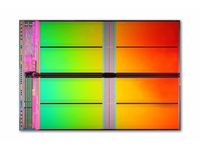IM Flash Starts Production on 34nm Flash Chips
IM Flash Technologies, a joint subsidiary of Intel and Micron, has starting production on 34nm, 32 gigabit multi-level cell flash chips.
In a move that will increase storage capacity while reducing size in flash memory, IT Flash Technologies has begun production on its 34nm line of NAND flash chips. Each chip will be able to hold 32 Gigabits (4 Gigabytes) of data. According to Electronista, the setup will likely be two layers, with each layer containing eight of the 32Gb/4GB cores, allowing for 64 GB of storage without the need for completely separate chips.
With no specific release date yet announced, many are expecting the chips to hit the market sometime in early 2009. This newest development would put IM Flash ahead of Toshiba, its largest competitor. Toshiba is expected to release a 32 GB chip based on a 43nm manufacturing tech on the same timeline as the 34nm from IM Flash.
Due to their size, the new chips will be targeted at handheld devices as well as netbooks, which traditionally use smaller flash-based hard drives instead of a form factor 1.8"/2.5"/3.5" drive like larger notebooks and desktops. Perhaps the biggest brand waiting for these new chips is Apple, who would likely use the new 64GB chips to upgrade capacities on their iPhones and iPod Touch devices. With the current design, Apple’s popular handhelds can take only one memory chip. With the new smaller offerings from IM Flash, expect to see the iPhone go beyond its current maximum of 16 GB and 32 GB for the iPod Touch.
Launched in 2006, IM Flash Technologies is a joint subsidiary of Intel Corporation and Micron Technologies. Micron is responsible for Intel’s foray into the Solid State Drive (SSD) market.
Get Tom's Hardware's best news and in-depth reviews, straight to your inbox.
-
afrobacon write speeds?Reply
If i can get one of these with decent write/read speeds I might be willing to upgrade my NES; as something smaller then a 2.5" drive it might allow for more airflow, meaning lower case temps when playing Excitebike. -
cushgod "technology doubles every 2 years about. and the cost drops in half every 2 years. . . I've heard this somewhere...Reply
